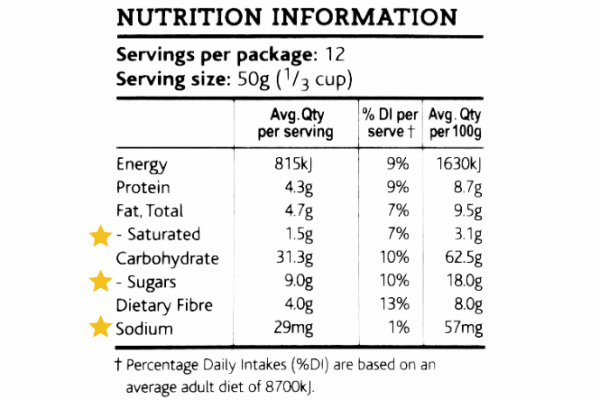1. Use the per 100g column
Most processed food labels contain a per serve column and a per 100g column. Serving sizes vary so it’s best to read the per 100g column to compare between products.
2. Sugar
Most NIPs refer to sugar in grams, so remember 1 teaspoon = 4 grams of sugar. It’s recommended that adults eat no more than about 12 teaspoons of sugar a day – and that includes sugar naturally occurring in honey, fruit and fruit juices as well as added sugar.
As a guide, food that has 15g or more per 100g is considered high in sugar. Anything under 5g of total sugar per 100g is low. Read more about how to cut down on sugar.
3. Salt
You should aim to eat no more than 5g of salt (sodium) per day. Salt is added to many foods, such as processed meat and sauces so it can be hard to know how much salt you’re eating each day and what 5g of salt actually ‘looks’ like.
A good rule of thumb is to choose foods containing less than 120mg of sodium per 100g. Foods containing 600mg per 100g are high salt choices and should be avoided. Read more about salt.
4. Saturated fat
All fats aren’t created equal – unsaturated fats don’t increase our risk of heart disease and are often referred to as good fats. Look for foods low in saturated fat and higher in unsaturated fats but remember that too much fat, even healthy ones, can cause weight gain.
5. Look at the ingredients list
The ingredients on an NIP are listed in order from the largest to smallest quantity. For example, if sugar is listed first it means it makes up the highest percentage of that product and is probably best avoided!
6. Compare products
Remembering all the different food recommendations is hard work, especially if you’re rushing to the shops after work or have little children helping with the grocery shopping. When you’re buying processed foods one of the easiest things you can do to make sure you’re making healthier choices is compare similar products to each other. Remember the three S’s – sugar, sodium and saturated fat, and choose the item with the least amount.
Image credit: Healthify He Puna Waiora, NZ
7. Watch out for allergens
Another very important piece of information on the food label is whether or not the product contains any common allergens (eg, nuts, dairy products, gluten, eggs and soy). These are often written in bold within the ingredients list and manufacturers are required by law to list them. However they are not legally required to add the ‘may contain traces of ...’ information you can see on some labels. When you see this it means that the food might unintentionally contain one of the listed allergens, eg, due to cross contamination.
8. Healthy guidelines
There's a general guideline known as the ‘10 10 5 rule’ to help you choose healthy food options. Look at the average quantity per 100g column and aim for foods that have less than 10g sugar, less than 10g fat and more than 5g fibre.






